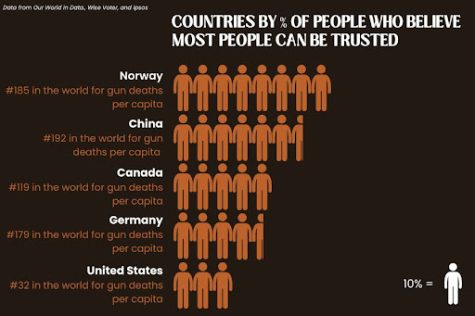American Distrust
May 31, 2023
“Stand your ground” laws have become relevant again after a string of independent shootings, all resulting from the victims’ simple mistakes and the actions of paranoid gun owners. This increase in shootings is most likely correlated with the inflated aggression levels following the COVID-19 pandemic and quarantine. Unsurprisingly, it’s common on social media sites such as Twitter, Facebook or Reddit for users to create dangerous echo chambers that lead to stark political polarization and environments that encourage individuals to hold extremist views. And as an increasing number of Americans hold extremist views, it is followed by an increase in shootings.
“I’m amazed at how quickly people react and, now, use a gun. I mean, that’s new. Everybody’s so fast to react. I truly think social media has brought that about because we all want information immediately. We see something, and we react right away, but the fact [that] guns [are] brought into it, that’s the more horrific end of it,” Crime and Law teacher Nancy Sachtleben said.
In a way, people have become all too happy to take disputes that should be left to the police into their own hands and shoot a gun. Some states have even nicknamed “stand your ground” laws “make my day” laws, implying that the excuse to shoot someone is almost a reward.
The percentage of American households that own one or more firearms has spiked in recent years, reaching a high of 45% in 2022. And while 48% of gun owners say they own a gun for self-protection purposes, less than 1% of crime victims reported using it in self-defense. The U.S. also owns far more guns than any other first-world country. In second place is Canada, which owns only one-third as many guns as the U.S. French teacher Blair Hopkins — who has lived in three countries, including the U.S. — has seen how citizens view guns and violence in various nations.
“[Americans’ protection of guns] doesn’t have anything to do with the Constitution. Americans are very, very attached to individual freedom. [Individual freedom] is one of the things I really like about living in the U.S., but people have a hard time seeing where [their individual rights] intrude on someone else’s right to do something,” Hopkins said.
This high concentration of gun ownership correlates with a concerning percentage of Americans who feel less trusting of others. In the 1970s, about half of Americans said they believed most people could be trusted. Now, that number is less than one-third. Additionally, the U.S. is the only established democracy with a decreasing trust level in both government and other people.

Ironically, these shootings are only an additional source of contention for the increasingly polarized two-party system. Democrats and Republicans are at odds about what to do in response to gun violence, with Democrats advocating for gun control and Republicans standing equally strongly against it. Either way, politicians are using important topics as leverage for their side, leading to people on all sides’ unmet needs.
“There’s more concern about crime and violence in the U.S.,” Hopkins said. “The two-party political division in the United States is much stronger and causes more tension than I have noticed in any other place I’ve lived.”
There is an unwarranted fear of crime in the U.S., with Americans’ fear of crime rising for the last two decades. This is often blamed on the media, with some claiming that the focus on crime in political news and the overexposure of criminals has skewed Americans’ perception of crime.
The fact that America has such a high amount of guns and a low level of trust is not a coincidence. The fear of crime and distrust in fellow citizens leads to an increase in the acquisition of guns and an increase in fear of others, continuing the mutual causality between distrust and gun violence. It becomes an incessant cycle: distrust leads to gun acquisition, which leads to gun violence which, in turn, leads to further gun violence and crimes.
